Small Spring系列二:BeanFactory(二)
愿君多采撷,此物最相思。

概述
在 Small Spring系列一:BeanFactory(一)
中,我们用 DefaultBeanFactory
读取 bean.xlm
中的 bean
信息,并且也实现了 BeanFactory
的 getBean()
方法。但是实现的方式有些不友好,本章,我们将优化和完善 BeanFactory
。
问题
你会发现在 DefaultBeanFactory
中存在读取 bean.xml
和反射创建对象两种操作,这不符合设计模式的 单一职责
。因此我们新增加一个 XmlBeanDefinitionReader
来读取 bean.xml
。但解析的 BeanDefinition
如何交给 BeanFactory
处理呢?这里我们可以在 BeanFactory
接口中增加 registerBeanDefinition(String beanID, BeanDefinition bd)
方法,将 XmlBeanDefinitionReader
解析的 BeanDefinition
注册到 BeanFactory
中。(此时 XmlBeanDefinitionReader
中需要持有一个 BeanFactory
的实例)。类图如下: 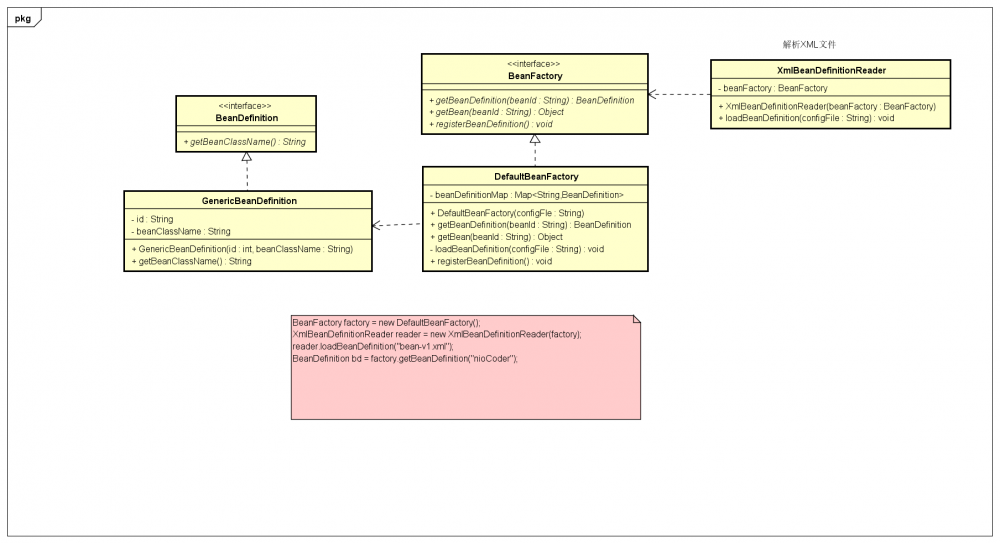
BeanFactory
/**
* 创建bean的实例
* @author zhenglongfei
*/
public interface BeanFactory {
/**
* 获取bean的定义
* @param beanId
* @return
*/
BeanDefinition getBeanDefinition(String beanId);
/**
* 获取bean的实例
* @param beanId
* @return
*/
Object getBean(String beanId);
/**
* 注册 BeanDefinition
* @param beanID
* @param bd
*/
void registerBeanDefinition(String beanID, BeanDefinition bd);
}
增加registerBeanDefinition(String beanID, BeanDefinition bd)方法
DefaultBeanFactory
/**
* BeanFactory的默认实现类
*
* @author zhenglongfei
*/
public class DefaultBeanFactory implements BeanFactory {
/**
* 存放BeanDefinition
*/
private final Map<String, BeanDefinition> beanDefinitionMap = new ConcurrentHashMap<>();
@Override
public BeanDefinition getBeanDefinition(String beanId) {
return this.beanDefinitionMap.get(beanId);
}
@Override
public Object getBean(String beanId) {
BeanDefinition bd = this.getBeanDefinition(beanId);
if (bd == null) {
throw new BeanCreationException("BeanDefinition does not exist");
}
ClassLoader cl = ClassUtils.getDefaultClassLoader();
String beanClassName = bd.getBeanClassName();
try {
// 使用反射创建bean的实例,需要对象存在默认的无参构造方法
Class<?> clz = cl.loadClass(beanClassName);
return clz.newInstance();
} catch (Exception e) {
throw new BeanCreationException("Bean Definition does not exist");
}
}
@Override
public void registerBeanDefinition(String beanID, BeanDefinition bd) {
this.beanDefinitionMap.put(beanID, bd);
}
}
去除loadBeanDefinition方法
XmlBeanDefinitionReader
读取解析 bean.xml
文件
/**
* @author zhenglongfei
*/
public class XmlBeanDefinitionReader {
private static final String ID_ATTRIBUTE = "id";
private static final String CLASS_ATTRIBUTE = "class";
BeanFactory beanFactory;
public XmlBeanDefinitionReader(BeanFactory beanFactory) {
this.beanFactory = beanFactory;
}
/**
* 具体解析bean.xml的方法 使用dom4j
*
* @param configFile
*/
public void loadBeanDefinition(String configFile) {
ClassLoader cl = ClassUtils.getDefaultClassLoader();
try (InputStream is = cl.getResourceAsStream(configFile)) {
SAXReader reader = new SAXReader();
Document doc = reader.read(is);
Element root = doc.getRootElement();
Iterator<Element> elementIterator = root.elementIterator();
while (elementIterator.hasNext()) {
Element ele = elementIterator.next();
String id = ele.attributeValue(ID_ATTRIBUTE);
String beanClassName = ele.attributeValue(CLASS_ATTRIBUTE);
BeanDefinition bd = new GenericBeanDefinition(id, beanClassName);
this.beanFactory.registerBeanDefinition(id, bd);
}
} catch (Exception e) {
throw new BeanDefinitionStoreException("IOException parsing XML document", e);
}
}
}
持有BeanFactory实例,解析bean.xml之后调用registerBeanDefinition(id, bd)将BeanDefinition注册到BeanFactory中
BeanFactoryTest
修改测试类
/**
* BeanFactory 测试类
*/
public class BeanFactoryTest {
/**
* 测试获取bean
*/
@Test
public void testGetBean() {
BeanFactory factory = new DefaultBeanFactory();
XmlBeanDefinitionReader reader = new XmlBeanDefinitionReader(factory);
reader.loadBeanDefinition("bean-v1.xml");
BeanDefinition bd = factory.getBeanDefinition("nioCoder");
assertEquals("com.niocoder.service.v1.NioCoderService", bd.getBeanClassName());
NioCoderService nioCoderService = (NioCoderService) factory.getBean("nioCoder");
assertNotNull(nioCoderService);
}
/**
* 测试无效的bean
*/
@Test
public void testInvalidBean() {
BeanFactory factory = new DefaultBeanFactory();
XmlBeanDefinitionReader reader = new XmlBeanDefinitionReader(factory);
reader.loadBeanDefinition("bean-v1.xml");
try {
factory.getBean("invalidBean");
} catch (BeanCreationException e) {
return;
}
Assert.fail("expect BeanCreationException ");
}
/**
* 测试无效的xml
*/
@Test
public void testInvalidXML() {
try {
BeanFactory factory = new DefaultBeanFactory();
XmlBeanDefinitionReader reader = new XmlBeanDefinitionReader(factory);
reader.loadBeanDefinition("bean.xml");
} catch (BeanDefinitionStoreException e) {
return;
}
Assert.fail("expect BeanDefinitionStoreException ");
}
}
使用XmlBeanDefinitionReader读取bean.xml
代码下载
- github: https://github.com/longfeizheng/small-spring/tree/20190916_BeanFactory_v2_1
优化1.0
我们再来重新审视一下 BeanFactory
接口中的方法,它现在除了 getBean(String beanId)
方法之外,还有 getBeanDefinition(String beanId)
和 registerBeanDefinition(String beanID, BeanDefinition bd)
。 registerBeanDefinition()
是用于 XmlBeanDefinitionReader
使用的, XmlBeanDefinitionReader
持有 BeanFactory
的实例,那么它也会知道 BeanFactory
的 getBean()
方法,并且 BeanFactory
我们只想用它来获取 bean
的实例,不想对外暴露太多,所以我们新增一个 BeanDefinitionRegistry
接口来注册和获取 BeanDefinition
。类图如下 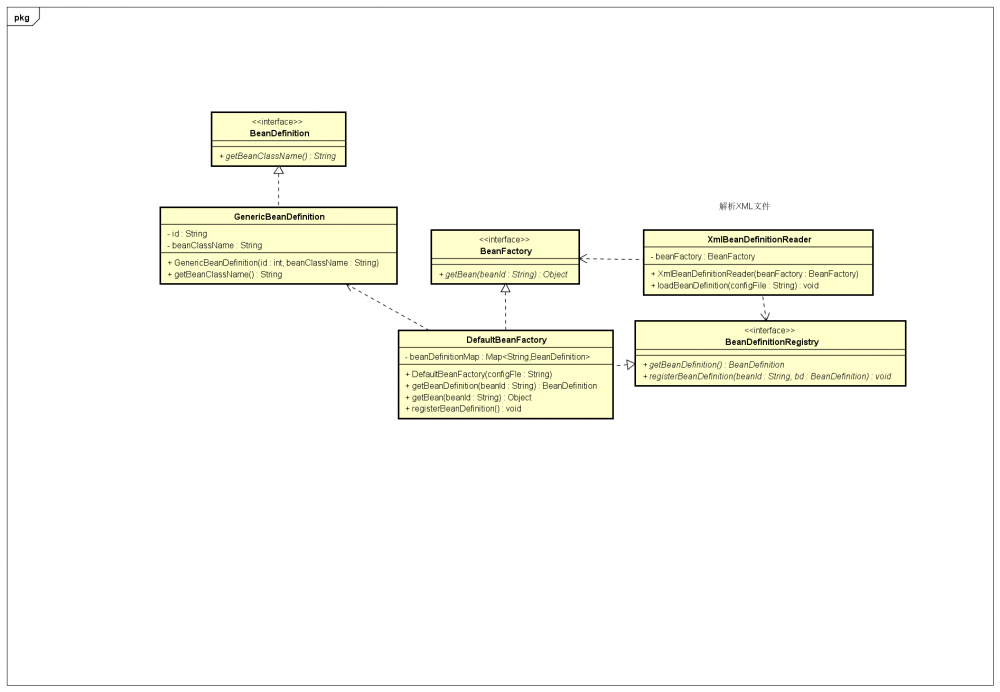
BeanFactory
/**
* 创建bean的实例
* @author zhenglongfei
*/
public interface BeanFactory {
/**
* 获取bean的实例
* @param beanId
* @return
*/
Object getBean(String beanId);
}
只保留getBean方法
BeanDefinitionRegistry
/**
* 注册BeanDefinition接口
*
* @author zhenglongfei
*/
public interface BeanDefinitionRegistry {
/**
* 获取beanDefinition
*
* @param beanId
* @return
*/
BeanDefinition getBeanDefinition(String beanId);
/**
* 注册beanDefinition
*
* @param beanId
* @param bd
*/
void registerBeanDefinition(String beanId, BeanDefinition bd);
}
把原先BeanFactory中getBeanDefinition()和registerBeanDefinition()提取到BeanDefinitionRegistry接口中
DefaultBeanFactory
public class DefaultBeanFactory implements BeanFactory, BeanDefinitionRegistry{
... ...
}
实现了BeanDefinitionRegistry接口
XmlBeanDefinitionReader
public class XmlBeanDefinitionReader{
......
BeanDefinitionRegistry registry;
public XmlBeanDefinitionReader(BeanDefinitionRegistry registry) {
this.registry = registry;
}
public void loadBeanDefinition(String configFile){
... ...
this.registry.registerBeanDefinition(id, bd);
}
}
由BeanFactory变成BeanDefinitionRegistry实例
代码下载
- github: https://github.com/longfeizheng/small-spring/tree/20190916_BeanFactory_v2_2
优化2.0.1
观察一下测试类 BeanFactoryTest
,当我们每次使用 BeanFactory
获取实例时,都需要使用到 XmlBeanDefinitionReader
的 loadBeanDefinition
方法。这有一些麻烦,我们该如何封装一下呢?这里我们新增一个 ApplicationContext
接口来封装这些操作。但由于配置文件的不确定性,有的可能存在 classpath
目录下,有的可能存在磁盘的目录下,又或者内存,网络等等。这里我们就简单的实现从 classpath
和磁盘目录两种情况。对应的 ClassPathXmlApplicationContext
和 FileSystemXmlApplicationContext
。由于 ClassPathXmlApplicationContext
和 FileSystemXmlApplicationContext
都需要读取文件,所以我们提取出来一个 Resource
接口,类图如下: 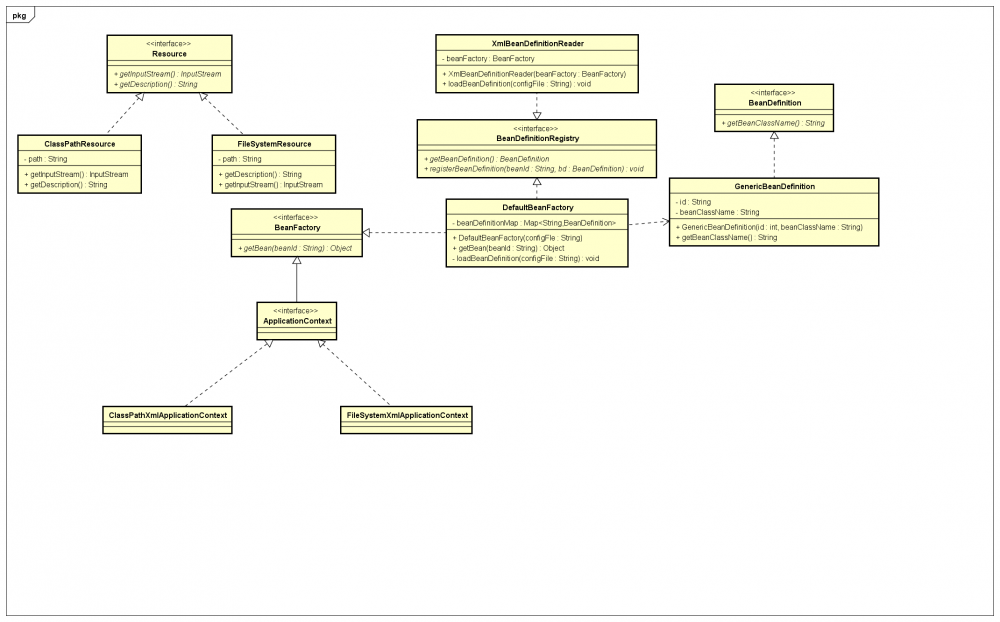
Resource
/**
* 抽取一个资源接口
*
* @author zhenglongfei
*/
public interface Resource {
/**
* 获取一个流
* @return
* @throws IOException
*/
InputStream getInputStream() throws IOException;
/**
* 获取文件的描述
* @return
*/
String getDescription();
}
提取一个获取资源的接口
ClassPathResource
public class ClassPathResource implements Resource {
private String path;
public ClassPathResource(String path) {
this.path = path;
}
@Override
public InputStream getInputStream() throws IOException {
InputStream is = ClassUtils.getDefaultClassLoader().getResourceAsStream(this.path);
if (is == null) {
throw new FileNotFoundException(path + " cannot be opened");
}
return is;
}
@Override
public String getDescription() {
return this.path;
}
}
从classpath下获取资源
FileSystemResource
public class FileSystemResource implements Resource {
private String path;
private File file;
public FileSystemResource(String path) {
this.path = path;
this.file = new File(path);
}
@Override
public InputStream getInputStream() throws IOException {
return new FileInputStream(this.file);
}
@Override
public String getDescription() {
return this.file.getAbsolutePath();
}
}
从磁盘目录下获取资源
XmlBeanDefinitionReader
public class XmlBeanDefinitionReader {
......
public void loadBeanDefinition(Resource resource) {
try (InputStream is = resource.getInputStream()) {
SAXReader reader = new SAXReader();
Document doc = reader.read(is);
Element root = doc.getRootElement();
Iterator<Element> elementIterator = root.elementIterator();
while (elementIterator.hasNext()) {
Element ele = elementIterator.next();
String id = ele.attributeValue(ID_ATTRIBUTE);
String beanClassName = ele.attributeValue(CLASS_ATTRIBUTE);
BeanDefinition bd = new GenericBeanDefinition(id, beanClassName);
this.registry.registerBeanDefinition(id, bd);
}
} catch (Exception e) {
throw new BeanDefinitionStoreException("IOException parsing XML document", e);
}
}
......
}
将参数修改为Resource
ApplicationContext
public interface ApplicationContext extends BeanFactory {
}
用于封装读取和解析bean.xml操作的接口
ClassPathXmlApplicationContext
public class ClassPathXmlApplicationContext implements ApplicationContext {
private DefaultBeanFactory factory = null;
public ClassPathXmlApplicationContext(String configFile) {
factory = new DefaultBeanFactory();
XmlBeanDefinitionReader reader = new XmlBeanDefinitionReader(factory);
Resource resource = new ClassPathResource(configFile);
reader.loadBeanDefinition(resource);
}
@Override
public Object getBean(String beanId) {
return factory.getBean(beanId);
}
}
从classpath下读取 bean.xml
FileSystemXmlApplicationContext
public class FileSystemXmlApplicationContext implements ApplicationContext {
private DefaultBeanFactory factory = null;
public FileSystemXmlApplicationContext(String configFile) {
factory = new DefaultBeanFactory();
XmlBeanDefinitionReader reader = new XmlBeanDefinitionReader(factory);
Resource resource = new FileSystemResource(configFile);
reader.loadBeanDefinition(resource);
}
@Override
public Object getBean(String beanId) {
return factory.getBean(beanId);
}
}
从系统磁盘目录读取文件
ApplicationContextTest
public class ApplicationContextTest {
@Test
public void testGetBeanFromClassPathContext() {
ApplicationContext context = new ClassPathXmlApplicationContext("bean-v1.xml");
NioCoderService nioCoderService = (NioCoderService) context.getBean("nioCoder");
Assert.assertNotNull(nioCoderService);
}
@Test
public void testGetBeanFromFileSystemContext() {
ApplicationContext context = new FileSystemXmlApplicationContext("src/test/resources/bean-v1.xml");
NioCoderService nioCoderService = (NioCoderService) context.getBean("nioCoder");
Assert.assertNotNull(nioCoderService);
}
}
测试ClassPathXmlApplicationContext和FileSystemXmlApplicationContext
代码下载
- github: https://github.com/longfeizheng/small-spring/tree/20190916_BeanFactory_v2_3
优化2.0.2
重复代码时万恶之源。在 ClassPathXmlApplicationContext
和 FileSystemXmlApplicationContext
的 的构造方法中有冗余代码,因此我们可以考虑使用 模板方法
来处理一下。类图如下: 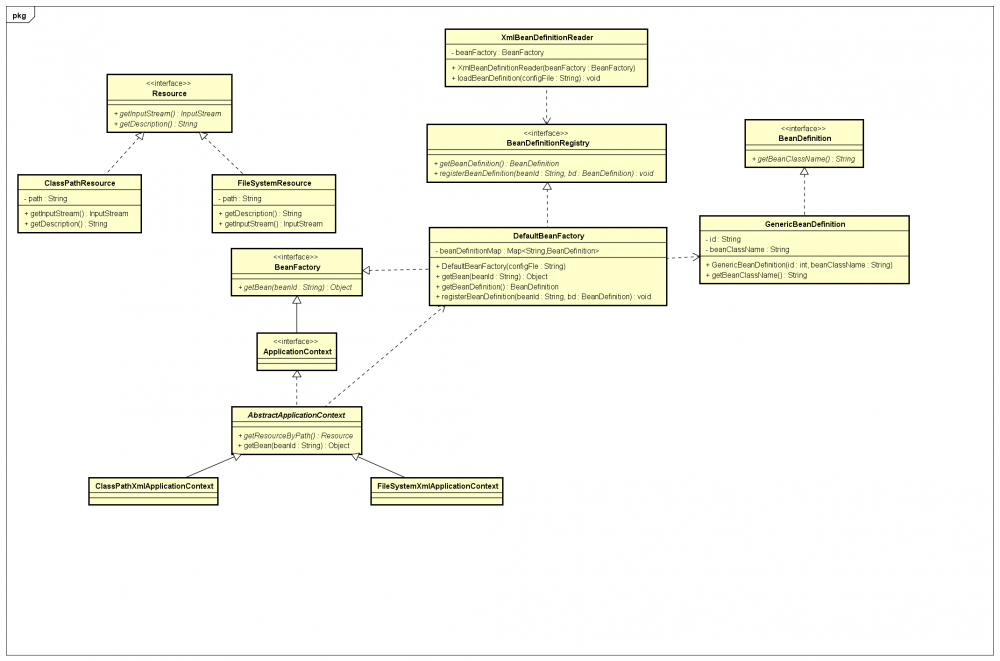
AbstractApplicationContext
public abstract class AbstractApplicationContext implements ApplicationContext {
private DefaultBeanFactory factory = null;
public AbstractApplicationContext(String configFile) {
factory = new DefaultBeanFactory();
XmlBeanDefinitionReader reader = new XmlBeanDefinitionReader(factory);
Resource resource = this.getResourceByPath(configFile);
reader.loadBeanDefinition(resource);
}
/**
* 具体由子类实现
*
* @param configFile
* @return
*/
protected abstract Resource getResourceByPath(String configFile);
@Override
public Object getBean(String beanId) {
return factory.getBean(beanId);
}
}
新增AbstractApplicationContext抽象类,里面增加getResourceByPath抽象方法
ClassPathXmlApplicationContext
public class ClassPathXmlApplicationContext extends AbstractApplicationContext {
public ClassPathXmlApplicationContext(String configFile) {
super(configFile);
}
@Override
protected Resource getResourceByPath(String configFile) {
return new ClassPathResource(configFile);
}
}
返回ClassPathResource
FileSystemXmlApplicationContext
public class FileSystemXmlApplicationContext extends AbstractApplicationContext {
public FileSystemXmlApplicationContext(String configFile) {
super(configFile);
}
@Override
protected Resource getResourceByPath(String configFile) {
return new FileSystemResource(configFile);
}
}
返回FileSystemResource
代码下载
- github: https://github.com/longfeizheng/small-spring/tree/20190916_BeanFactory_v2_4
优化3.0
至此已经完成了增加 BeanDefinitionRegistry
实现接口单一职责, ApplicationContext
封装 bean.xml
的解析和实例化。接下来我们来处理 scope
的问题。这里我们只是简单区分一下一个 bean
是否单例。为了实现接口细粒度化,我们新增 SingletonBeanRegistry
来区分一个bean是否单例。类图如下:
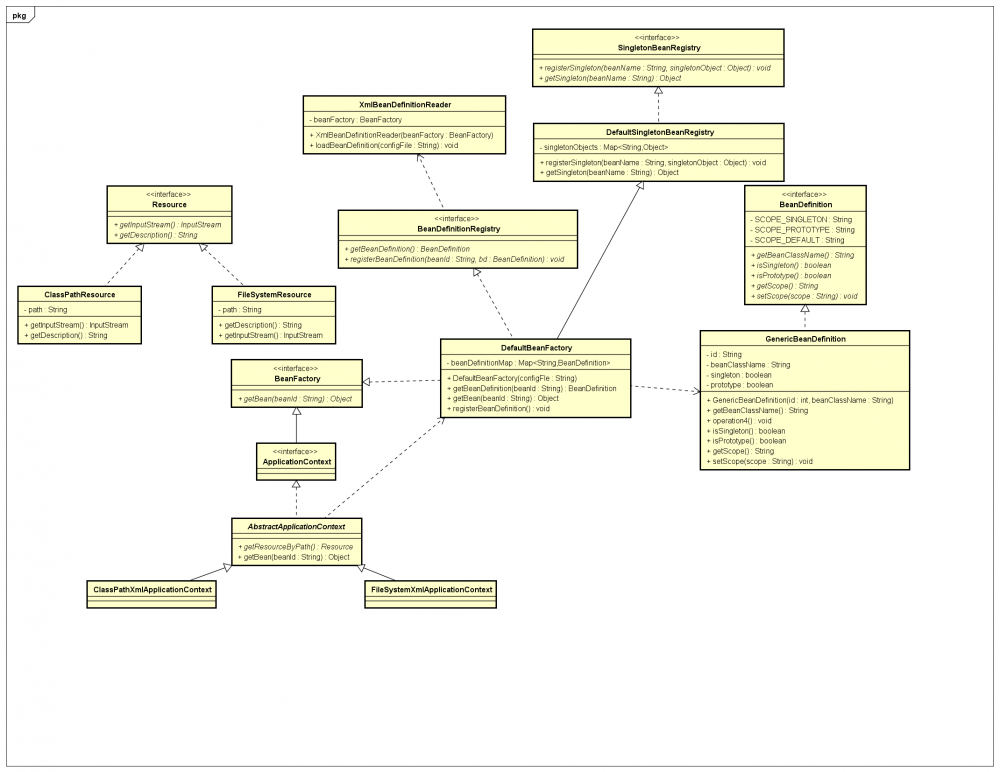
BeanDefinition
public interface BeanDefinition {
/**
* 单例
*/
String SCOPE_SINGLETON = "singleton";
/**
* 多例
*/
String SCOPE_PROTOTYPE = "prototype";
/**
* 默认为空即单例模式
*/
String SCOPE_DEFAULT = "";
/**
* 是否为单例
*
* @return
*/
boolean isSingleton();
/**
* 是否为多例
*
* @return
*/
boolean isPrototype();
/**
* 获取scope配置
*
* @return
*/
String getScope();
/**
* 设置scope
*
* @param scope
*/
void setScope(String scope);
/**
* 获取bean.xml中 bean的全名 如 "com.niocoder.service.v1.NioCoderService"
*
* @return
*/
String getBeanClassName();
}
单例多例为bean的属性,所以需要修该BeanDefinition
GenericBeanDefinition
public class GenericBeanDefinition implements BeanDefinition {
private String id;
private String beanClassName;
private boolean singleton = true;
private boolean prototype = false;
private String scope = SCOPE_DEFAULT;
public GenericBeanDefinition(String id, String beanClassName) {
this.id = id;
this.beanClassName = beanClassName;
}
@Override
public boolean isSingleton() {
return this.singleton;
}
@Override
public boolean isPrototype() {
return this.prototype;
}
@Override
public String getScope() {
return scope;
}
@Override
public void setScope(String scope) {
this.scope = scope;
this.singleton = SCOPE_SINGLETON.equals(scope) || SCOPE_DEFAULT.equals(scope);
this.prototype = SCOPE_PROTOTYPE.equals(scope);
}
@Override
public String getBeanClassName() {
return this.beanClassName;
}
}
修改BeanDefinition的实现
XmlBeanDefinitionReader
public class XmlBeanDefinitionReader {
public void loadBeanDefinition(Resource resource) {
......
if (ele.attribute(SCOPE_ATTRIBUTE) != null) {
bd.setScope(ele.attributeValue(SCOPE_ATTRIBUTE));
}
this.registry.registerBeanDefinition(id, bd);
......
}
}
如果bean.xml中配置scope属性则设置scope
SingletonBeanRegistry
public interface SingletonBeanRegistry {
/**
* singlebean 注册
*
* @param beanName
* @param singletonObject
*/
void registerSingleton(String beanName, Object singletonObject);
/**
* 获取singlebean
*
* @param beanName
* @return
*/
Object getSingleton(String beanName);
}
表示bean 为singleton的接口
DefaultSingletonBeanRegistry
public class DefaultSingletonBeanRegistry implements SingletonBeanRegistry {
private final Map<String, Object> singletonObjects = new ConcurrentHashMap<>(64);
@Override
public void registerSingleton(String beanName, Object singletonObject) {
Assert.notNull(beanName, "'beanName' must not be null");
Object oldObject = this.singletonObjects.get(beanName);
if (oldObject != null) {
throw new IllegalStateException("Could not register object [" + singletonObject +
"] under bean name '" + beanName + "': there is already object [" + oldObject + "] bound");
}
this.singletonObjects.put(beanName, singletonObject);
}
@Override
public Object getSingleton(String beanName) {
return this.singletonObjects.get(beanName);
}
}
SingletonBeanRegistry的实现类
DefaultBeanFactory
public class DefaultBeanFactory extends DefaultSingletonBeanRegistry implements BeanFactory, BeanDefinitionRegistry {
......
@Override
public Object getBean(String beanId) {
BeanDefinition bd = this.getBeanDefinition(beanId);
if(bd == null){
return null;
}
if(bd.isSingleton()){
Object bean = this.getSingleton(beanId);
if(bean == null){
bean = createBean(bd);
this.registerSingleton(beanId, bean);
}
return bean;
}
return createBean(bd);
}
private Object createBean(BeanDefinition bd) {
ClassLoader cl = ClassUtils.getDefaultClassLoader();
String beanClassName = bd.getBeanClassName();
try {
Class<?> clz = cl.loadClass(beanClassName);
// 使用反射创建bean的实例,需要对象存在默认的无参构造方法
return clz.newInstance();
} catch (Exception e) {
throw new BeanCreationException("create bean for "+ beanClassName +" failed",e);
}
}
......
}
getBean时判断是否为singleton
BeanFactoryTest
public class BeanFactoryTest {
......
/**
* 测试获取bean
*/
@Test
public void testGetBean() {
reader.loadBeanDefinition(new ClassPathResource("bean-v1.xml"));
BeanDefinition bd = factory.getBeanDefinition("nioCoder");
assertTrue(bd.isSingleton());
assertFalse(bd.isPrototype());
assertEquals(BeanDefinition.SCOPE_DEFAULT, bd.getScope());
assertEquals("com.niocoder.service.v1.NioCoderService", bd.getBeanClassName());
NioCoderService nioCoderService = (NioCoderService) factory.getBean("nioCoder");
assertNotNull(nioCoderService);
NioCoderService nioCoderService1 = (NioCoderService) factory.getBean("nioCoder");
assertTrue(nioCoderService.equals(nioCoderService1));
}
......
}
测试默认的bean getBean时判断是否为singleton
代码下载
- github: https://github.com/longfeizheng/small-spring/tree/20190916_BeanFactory_v2_5
代码下载
- github: https://github.com/longfeizheng/small-spring
- 本文标签: 实例 BeanDefinition root HashMap CTO final NIO tab stream 配置 DOM 下载 spring bus https 设计模式 参数 ioc classpath 构造方法 map Document ACE 目录 id git 代码 value bean 测试 equals cat 解析 http Master ip GitHub 2019 XML Service ssl ConcurrentHashMap description App src IO db 类图 IDE
- 版权声明: 本文为互联网转载文章,出处已在文章中说明(部分除外)。如果侵权,请联系本站长删除,谢谢。
- 本文海报: 生成海报一 生成海报二










![[HBLOG]公众号](https://www.liuhaihua.cn/img/qrcode_gzh.jpg)

